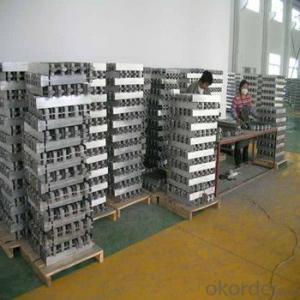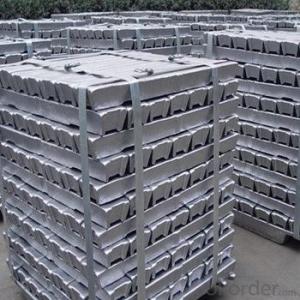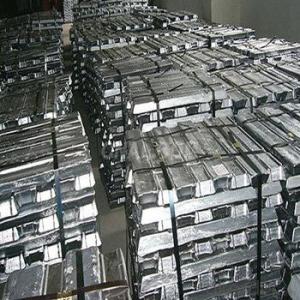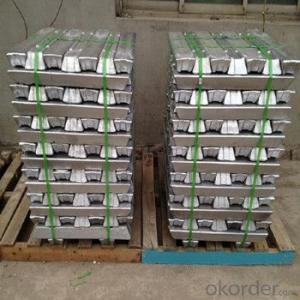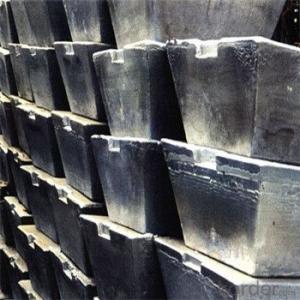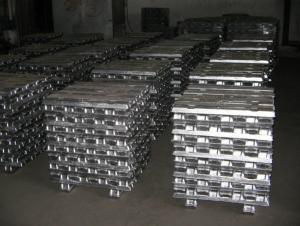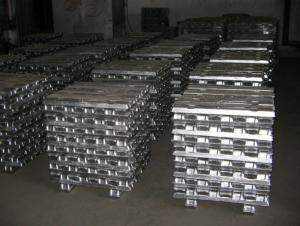Aluminium Ingot With High Grade 99.7% For Hot Sale
- Loading Port:
- China main port
- Payment Terms:
- TT OR LC
- Min Order Qty:
- 1000 m.t
- Supply Capability:
- 10000 m.t/month
OKorder Service Pledge
OKorder Financial Service
You Might Also Like
Pure Aluminum Ingot Used for Industry
1.Structure of Aluminum Ingot Description
An ingot is a piece of material, usually metal, that is cast into a shape suitable for further processing. Insteelmaking, it is the first step among semi-finished casting products. Ingots usually require a second procedure of shaping, such as cold/hot working, cutting, or milling to produce a useful final product. Non-metallic and semiconductor materials prepared in bulk form may also be referred to as ingots, particularly when cast by mold based methods.
2.Main Features of the Aluminum Ingot
•High Purity
•High strength
•Fast melting
•Best price
•Good after-service
3. Aluminum Ingot Images
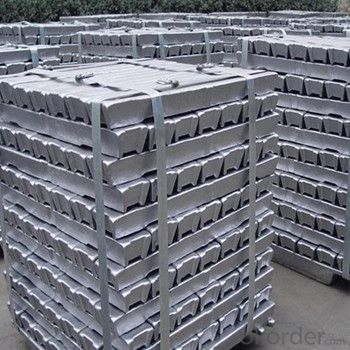
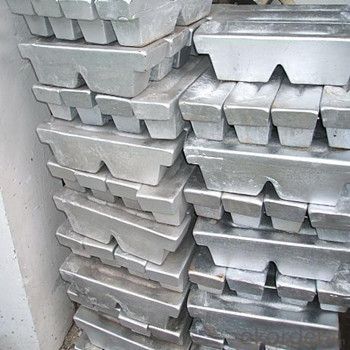
4. Aluminum Ingot Specification
Grade | Chemical Composition % | |||||||||
Al≥ | impurities ≤ | |||||||||
Si | Fe | Cu | Ga | Mg | Zn | Mn | others | Sum | ||
Al99.9 | 99.90 | 0.50 | 0.07 | 0.005 | 0.02 | 0.01 | 0.025 | - | 0.010 | 0.10 |
Al99.85 | 99.85 | 0.80 | 0.12 | 0.005 | 0.03 | 0.02 | 0.030 | - | 0.015 | 0.15 |
Al99.7 | 99.70 | 0.10 | 0.20 | 0.010 | 0.03 | 0.02 | 0.030 | - | 0.030 | 0.30 |
Al99.6 | 99.60 | 0.16 | 0.25 | 0.010 | 0.03 | 0.03 | 0.030 | - | 0.030 | 0.40 |
Al99.5 | 99.50 | 0.22 | 0.30 | 0.020 | 0.03 | 0.05 | 0.050 | - | 0.030 | 0.50 |
Al99.00 | 99.00 | 0.42 | 0.50 | 0.020 | 0.03 | 0.05 | 0.050 | - | 0.050 | 1.00 |
5.FAQ of Aluminum Ingot
We have organized several common questions for our clients,may help you sincerely:
①How about your company?
A world class manufacturer & supplier of castings forging in carbon steel and alloy steel,is one of the large-scale professional investment casting production bases in China,consisting of both casting foundry forging and machining factory. Annually more than 8000 tons Precision casting and forging parts are exported to markets in Europe,America and Japan. OEM casting and forging service available according to customer’s requirements.
②How to guarantee the quality of the products?
We have established the international advanced quality management system,every link from raw material to final product we have strict quality test;We resolutely put an end to unqualified products flowing into the market. At the same time, we will provide necessary follow-up service assurance.
③How long can we receive the product after purchase?
In the purchase of product within three working days, We will arrange the factory delivery as soon as possible. The pecific time of receiving is related to the state and position of customers.Commonly 7 to 10 working days can be served.
- Q:What are the different surface coatings for aluminum ingots?
- Aluminum ingots can be treated with different surface coatings, each serving a specific purpose. The most commonly used coating is anodizing, which involves an electrochemical process that creates a protective oxide layer on the aluminum surface. Anodized aluminum offers improved durability, increased corrosion resistance, and can be dyed in various colors. Another option is powder coating, where a dry powder is applied to the aluminum surface and then cured under heat to form a hard, protective layer. This type of coating provides excellent resistance to abrasion, impact, and chemicals, and it can be applied in a wide range of colors and finishes. For applications requiring enhanced lubricity or low friction, a Teflon or PTFE (polytetrafluoroethylene) coating can be utilized. This coating reduces friction and wear, improves release properties, and offers excellent chemical resistance. In certain cases, aluminum ingots may also undergo galvanization, which involves coating them with a thin layer of zinc. This zinc coating provides protection against corrosion and can be further enhanced by applying a powder coating or paint on top. Additionally, various organic coatings such as acrylic, epoxy, or polyurethane can be applied to aluminum ingots to achieve a decorative finish or protect against environmental factors like UV radiation or moisture. Ultimately, the choice of surface coating for aluminum ingots depends on specific application requirements, such as the need for corrosion resistance, durability, friction reduction, or aesthetic appeal.
- Q:What are the challenges in recycling scrap aluminum ingots?
- One of the challenges in recycling scrap aluminum ingots is the presence of impurities and contaminants. These impurities can affect the quality of the recycled aluminum and may require additional processing steps to remove them effectively. Additionally, the collection and sorting of scrap aluminum can be challenging due to its widespread use in various industries, leading to difficulties in sourcing sufficient quantities of clean and uncontaminated scrap material. Finally, the energy-intensive nature of aluminum production and recycling poses a challenge in terms of the environmental impact and cost-effectiveness of the recycling process.
- Q:How are aluminum ingots used in the production of electronic devices?
- Aluminum ingots are primarily used in the production of electronic devices as a material for creating casings and housings. The ingots are melted and shaped into desired forms, providing a lightweight yet durable structure for electronic devices such as smartphones, laptops, and tablets. Aluminum's excellent thermal conductivity also helps in dissipating heat generated by electronic components, ensuring optimal performance and preventing overheating issues. Additionally, the corrosion-resistant properties of aluminum make it a popular choice for protecting electronic circuits from external elements.
- Q:What are the main factors influencing the choice between aluminum ingots and aluminum forgings?
- The main factors influencing the choice between aluminum ingots and aluminum forgings include the desired strength and durability of the final product, the complexity of the desired shape, the required dimensions and tolerances, the anticipated production volume, and the available budget.
- Q:How can aluminium ingots be cast into aluminium plates?
- The hot rolled aluminum ingot can be obtained by hot extrusion, and the slab can be obtained by hot rolling, pickling, annealing and cold rolling.
- Q:What are the different machining techniques for aluminum ingots?
- Some of the different machining techniques for aluminum ingots include milling, drilling, turning, and grinding.
- Q:What quality aluminium ingots can be made out of pop cans?
- In fact, the recycled aluminum slag can also be used for smelting aluminum ingots. But it doesn't work well. It needs stirring and a lot of slag. There is also a saying that the only way aluminum slag smelting aluminum ingot is electrolysis, the use of reduction method is too expensive
- Q:What are the health risks associated with working with aluminum ingots?
- Working with aluminum ingots can pose certain health risks due to the potential exposure to various hazards. Here are some of the health risks associated with working with aluminum ingots: 1. Inhalation of aluminum particles: During the handling and processing of aluminum ingots, there is a risk of inhaling fine aluminum particles. Prolonged exposure to aluminum dust or fumes can lead to respiratory problems such as bronchitis, pulmonary fibrosis, or even lung cancer. 2. Skin and eye irritation: Direct contact with aluminum ingots or its dust can cause skin irritation, redness, and rashes. In some cases, it may also cause eye irritation, leading to redness, itching, or burning sensation. 3. Neurological effects: Chronic exposure to aluminum, especially through inhalation or ingestion, has been associated with potential neurological effects. Although the exact mechanisms are not fully understood, there is some evidence linking aluminum exposure to the development or progression of neurodegenerative diseases, such as Alzheimer's disease. 4. Occupational asthma: Exposure to aluminum dust or fumes can trigger or exacerbate asthma symptoms in individuals who are already prone to respiratory conditions. This can result in difficulty breathing, wheezing, coughing, and chest tightness. 5. Heavy metal toxicity: Aluminum is considered a heavy metal, and excessive exposure can lead to heavy metal toxicity. Symptoms of aluminum toxicity may include gastrointestinal issues, bone pain, muscle weakness, and even potential damage to the nervous system. To mitigate these health risks, it is essential to implement appropriate safety measures and follow proper protocols while working with aluminum ingots. This includes wearing personal protective equipment (PPE) such as gloves, goggles, and respiratory masks, ensuring proper ventilation in the workplace, and implementing regular cleaning procedures to minimize the accumulation of aluminum dust. Additionally, regular medical check-ups and monitoring are recommended for individuals who work with aluminum ingots to detect any potential health issues at an early stage.
- Q:Can aluminum ingots be anodized?
- Yes, aluminum ingots can be anodized. Anodizing is an electrochemical process that forms a protective oxide layer on the surface of aluminum. This process can be applied to aluminum ingots, sheets, or other forms. Anodizing provides several benefits such as increased corrosion resistance, improved durability, and the ability to add color to the surface. The anodized layer also enhances the aesthetic appearance of the aluminum and allows for better adhesion of paints or dyes. Overall, anodizing aluminum ingots is a common practice in various industries to enhance the properties and appearance of the metal.
- Q:What are the scouring agents in the die casting process, such as slag remover, coating agent, flux, and what matters should be paid attention to when the aluminium ingot is dissolved?,
- Deslagging agentRemove scum from liquid metal
1. Manufacturer Overview |
|
|---|---|
| Location | |
| Year Established | |
| Annual Output Value | |
| Main Markets | |
| Company Certifications | |
2. Manufacturer Certificates |
|
|---|---|
| a) Certification Name | |
| Range | |
| Reference | |
| Validity Period | |
3. Manufacturer Capability |
|
|---|---|
| a)Trade Capacity | |
| Nearest Port | |
| Export Percentage | |
| No.of Employees in Trade Department | |
| Language Spoken: | |
| b)Factory Information | |
| Factory Size: | |
| No. of Production Lines | |
| Contract Manufacturing | |
| Product Price Range | |
Send your message to us
Aluminium Ingot With High Grade 99.7% For Hot Sale
- Loading Port:
- China main port
- Payment Terms:
- TT OR LC
- Min Order Qty:
- 1000 m.t
- Supply Capability:
- 10000 m.t/month
OKorder Service Pledge
OKorder Financial Service
Similar products
New products
Hot products
Hot Searches
Related keywords
